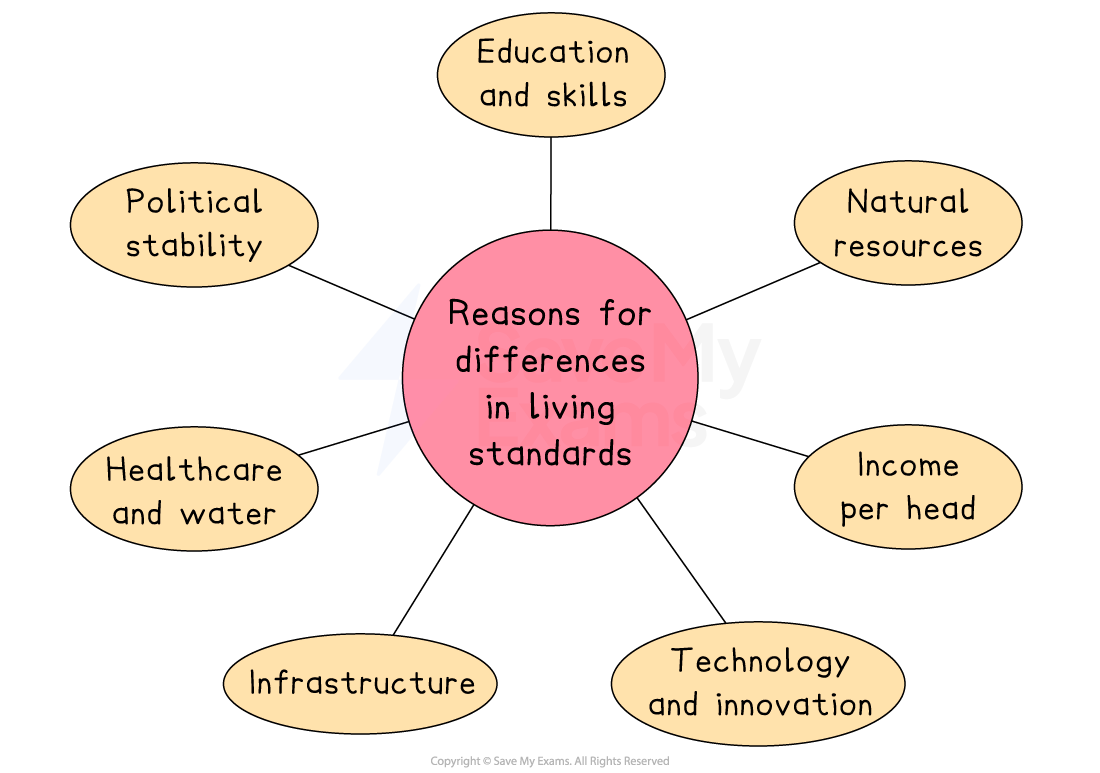Syllabus Edition
First teaching 2025
First exams 2027
Comparing Living Standards (Cambridge (CIE) IGCSE Economics): Revision Note
Exam code: 0455 & 0987
Reasons for differences in living standards
Living standards refer to the general well-being and quality of life experienced by individuals in a country or region
This topic explores why some countries and people enjoy higher living standards than others, and why income is not evenly distributed (income inequality)

Explaining the reasons that affect living standards
Reason | Explanation |
|---|---|
Income per head (GDP per capita) |
|
Natural resources |
|
Level of education and skills |
|
Political stability and good governance |
|
Access to healthcare and clean water |
|
Infrastructure |
|
Technology and innovation |
|
Reasons for differences in income distribution
These are the key factors that explain why some individuals or groups earn more than others within a country, leading to income inequality.
1. Education and skills
People with higher levels of education and training tend to get better-paying jobs
Those with specialist or in-demand skills (e.g., coding, AI, medicine) often earn much more than unskilled workers
For example, in India, access to quality education is unequal, especially in rural areas, leading to wide income disparities between skilled and unskilled workers
2. Inheritance and wealth ownership
Some people are born into wealthy families and inherit land, property or business assets, giving them an advantage
Wealth ownership allows individuals to earn income from rents, dividends or investments, even without working
For example, in South Africa, historical inequalities continue to impact who owns productive assets like land and businesses, whereas in Japan there was an equal distribution of land after World War 2, which helped reduce extreme wealth concentration across generations
3. Government policy (taxes and welfare)
Progressive taxes (higher earners pay more) and generous welfare systems can reduce income inequality
Weak tax systems or limited welfare can widen the income gap
For example, in Sweden, a strong welfare state and progressive tax system help reduce income inequality, whereas in the United States, weaker social safety nets and lower taxes on high incomes contribute to a larger income gap
4. Employment opportunities
People in urban areas often have access to higher-paying jobs, while those in rural areas may rely on farming or informal work
Job availability and wages can differ between regions and industries, depending on investment and development levels
For example, in Brazil, employment and wealth are heavily concentrated in urban coastal cities, whereas in Germany, regional investment and better infrastructure help spread employment opportunities more evenly across the country
5. Discrimination
Some people may face unequal treatment in the labour market due to gender, ethnicity, age or disability
This can limit job access, promotions or pay for certain groups
For example, in Pakistan, gender discrimination limits many women’s access to high-paying jobs and equal treatment in the labour market, whereas in Iceland, strong gender equality laws have significantly narrowed the gender pay gap
6. Rural vs urban divide
People in rural areas often have poorer access to education, healthcare, and well-paid jobs
This results in lower incomes and fewer opportunities, even within the same country
For example, in Nigeria, rural populations have much lower access to services and jobs compared to urban dwellers, whereas in South Korea, rural investment in infrastructure and education has helped close the rural–urban income gap

Unlock more, it's free!
Did this page help you?